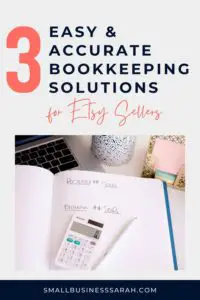When Etsy announced a partnership with QuickBooks to provide QuickBooks for Etsy, I knew I had to check it out. As an accountant, I am very picky about my accounting software. As an Etsy Seller, I want quick and easy financial data. This was the perfect opportunity to test and find the best accounting software for Etsy sellers.
QuickBooks for Etsy uses a version of QuickBooks called QuickBooks Self-Employed. I have been using QuickBooks Simple Start, for many years. Keep in mind that QuickBooks Self Employed is a completely different type of program than QuickBooks Simple Start. Same company, completely different program.
In this article, I will discuss both QuickBooks Self-Employed and QuickBooks Simple Start. In addition, I had also heard many Etsy sellers rave about Go Daddy Bookkeeping for Etsy sellers. This seemed like a perfect opportunity to test and compare all three programs.
Let me help you find the best accounting software for you, as an Etsy seller, so you can get your Etsy bookkeeping done super fast each month!
This article contains affiliate links for products I use and recommend. See my disclosure here.
[thrive_headline_focus title=”The Similarities” orientation=”left”]
Let’s begin with what the three accounting programs have in common. All three are web-based accounting programs, eliminating the hassle of buying or downloading software. All three will allow you to connect their accounting program to your bank account and credit card account. This is a huge plus as it allows every financial transaction to be automatically imported into the program saving lots of time. All three are great at memorizing transactions which also saves a lot of time in coding and categorizing transactions. All three are relatively low cost. QuickBooks for Etsy and GoDaddy are only $10/month at their regular price, and QuickBooks Simple Start is only $25.
That’s pretty much where the universal similarities end. Now let’s look at each accounting program separately to discuss it’s merits and flaws. By the end you will know which accounting software is best for you and your Etsy shop. Etsy bookkeeping done! Tax time a breeze!

[thrive_headline_focus title=”QuickBooks for Etsy (QuickBooks Self-Employed)” orientation=”left”]
I had high hopes for QuickBooks for Etsy, unfortunately, it is my least favorite choice hands down. In fact, I would downright discourage people from using this program. Why the strong language? Let me explain.
With regular accounting software, financial information is imported only from bank accounts and credit cards. The idea behind QuickBooks for Etsy is that some detail information will be imported directly from Etsy. So transactions are broken down into their components at the Etsy level.
Although QuickBooks for Etsy does import some transaction breakdown information from Etsy into QuickBooks, it does not import everything. What it gets right is the importing of some of the Etsy fees such as listing, marketing, postage and transaction fees.
When it comes to importing Etsy sales, QuickBooks for Etsy falls way short. It imports the item cost + sales tax + shipping revenue all as one number and only breaks out the card processing fee. As an example, a customer purchased a $14 product paid $4.27 shipping and $.98 in sales tax. The card processing fee was $.83. QB for Etsy only imported $19.25 revenue and the $.83 fee. The shipping and sales tax is netted with the product. The ability to break out shipping is a key part of reporting your revenue to the IRS and a key part in understanding your businesses financial picture, but that is the part that is completely missing.
Speaking of sales tax, QuickBooks Self-Employed does not track Sales Tax. Within the program, there is no way of knowing how much sales tax you have collected and need to remit to your state. For a program claiming to link financial data from your Etsy shop, they are missing some pretty key financial components.
There is zero ability within QuickBooks Self-Employed to add manual transactions or customize your accounts. So there will never be any ability to add sales tax on your own to track within the program. There is no ability to make adjustments or journal entries.
I could go on with issues and problems with QuickBooks for Etsy, but I think these major glaring errors should be enough to steer you away. Take a look at the chart below for more info, or feel free to get in touch with questions.
[thrive_headline_focus title=”GoDaddy Bookkeeping Essentials” orientation=”left”]
Many Etsy Sellers rave about GoDaddy, so I tested their accounting program as well. GoDaddy has several nice features especially for Etsy Seller’s.
GoDaddy Bookkeeping Essentials does link to your Etsy shop and imports financial transactions. And unlike QuickBooks for Etsy, GoDaddy imports all the breakdowns of Etsy expenses and Etsy revenue. Off to a good start!
With GoDaddy, you can also customize your account names, add manual transactions, track sales tax, track mileage, track hours, and more. It is a fairly comprehensive program that is easy to use.
One thing I love about GoDaddy is that each week I get an email showing my profit and loss for the week, how much money I have in my bank account, and how much money I owe on my credit card or on my Etsy Bill. It’s a quick and easy way to get a glance at my current financial picture.
There are two main drawbacks to GoDaddy. First, it is a single entry accounting system. Generally Accepted Accounting Principles calls for the use of a double entry accounting system. Basically, each transaction has two sides. If you pay a bill, the expense account is affected, but so is the cash account. GoDaddy tracks the Profit and Loss side of your business (the revenue and expense side), but it falls short tracking the Balance Sheet side of your business (cash, receivables, payables). There is a reason why the double entry system is accounting best practice, it prevents errors and presents fully accurate information. Sometimes the lack of the double entry system creates situations where you are double counting transactions. For instance, GoDaddy records the revenue from your Etsy shop as each order is placed. But it also records the revenue when your Etsy payment account makes a deposit in your checking account. If you don’t know to look for that double counting, your financial data will be way off.
GoDaddy does have a way for you to deal with the double counting. You can simply click on the transaction and label it as non-business, GoDaddy will remember going forward not to count these types of transactions. So there is a solution, but the fact that it happens at all is not great.
The second main issue with GoDaddy is lack of the ability to reconcile accounts. Performing a bank reconciliation and credit card reconciliation is an important step in ensuring accurate financial data and catching errors. GoDaddy does not have a reconciliation feature. So if you have made any error in recording your financial transactions, there is no way to catch it.
Despite these drawbacks, I do think GoDaddy is a good choice for Etsy Seller’s. As an accountant, it’s missing some features I use on a regular basis. But for an Etsy seller in need of a simple solution, I think it’s a fine option.
[thrive_headline_focus title=”QuickBooks Simple Start” orientation=”left”]
Last but not least is QuickBooks Simple Start. QuickBooks Simple Start is a program that is easy to use, yet it is comprehensive and contains all features that would allow a business to comply with Generally Accepted Accounting Principles. It is my top recommendation for Etsy sellers and other businesses.
It links to your bank accounts and credit cards to automatically import transactions. You can customize your account names, make manual entries, track sales tax, send invoices and much more. QuickBooks Simple Start does a great job at memorizing transactions to make bookkeeping simple.
What I love about QuickBooks Simple Start is that it functions on the double entry system, has a reconciliation feature, can produce any type of accounting report I could need, can produce a balance sheet report, not just a profit and loss, and allows me to easily post journal entries. It is easy, but comprehensive. It can grow with your business as your business expands because it has advanced features included and more advanced features you can add on later.
So the elephant in the room is that QuickBooks Simple Start does not connect with Etsy. Is this a problem if you are an Etsy seller? Absolutely not.
The accountant preferred and sanctioned way to add transactions to your books, is to pull those transactions directly from bank statements and credit cards. This is how QuickBooks Simple Start works, it provides the most accurate information and avoids the risk of double counting and errors.
However, it is not overly helpful to just have one big Etsy deposit every week. What portion was shipping, what fees did I pay, what was sales tax? That’s why each month I make a simple adjusting entry to pull out that information. This entry only takes a few minutes each month.
Now I know these adjustments are easy for me because I am an accountant, but I promise it will be easy for you too! I created this video of the monthly adjustment, to show you exactly what to do. Just follow it step by step.
Update: I hired a programmer, and he created a web program for me that will calculate your Etsy entry for you! It’s free to use! I call it the Etsy Entry App. Simply upload two Etsy CSV files each month, press the button, and it will automatically calculate your Etsy entry for you each month. Easy peasy! Your monthly Etsy bookkeeping is done!
This video is with the new Etsy payment account system they rolled out in November 2018. So everything is up to date and ready to go!
This adjustments is simple and takes very little time each month. To help you further I have a Quick Start Guide to Quick Books post here.
[thrive_headline_focus title=”Conclusion” orientation=”left”]
So what will you choose? What sounds to you like the best accounting software for Etsy sellers? The more accurate but easy QuickBooks Simple Start? The newbie and Etsy linked GoDaddy? No matter what, pick one! Don’t delay on choosing and using an accounting program! The most important thing is to just get started so you can get your Etsy bookkeeping done!
Need a bit more help? I offer monthly bookkeeping services for Etsy sellers at a super affordable price! (Done for you bookkeeping services starting at only $99 a month!)
Here is a chart comparison if this helps you think and process!
| QB for Etsy (QB Self-Employed) | GoDaddy Essentials | QB Simple Start | ||
| Cost | $10/mo | $10/mo | $25/mo | |
| Automatically Imports bank and credit card transactions | Yes | Yes | Yes | |
| Automatically Imports Etsy Revenue into all components (Shipping, Processing Fee, Sales Tax, Net Revenue) | No | Yes | No | |
| Automatically Imports Etsy Bill into it’s components (transaction fees, listing fees, promoted listings, shipping labels) | Yes | Yes | No | |
| Ability to exclude personal transactions | Yes | Yes | Yes | |
| Ability to Customize Account Names/Chart of Accounts | No | Yes | Yes | |
| Compiles Profit & Loss Reports | Yes | Yes | Yes | |
| Can Create a Balance Sheet Report | No | No | Yes | |
| Ability to add transactions manually | No | Yes | Yes | |
| Ability to track Sales Tax | No | Yes | Yes | |
| Ability to Split Transactions between accounts | No | Yes | Yes | |
| Eliminates risk of double counting transactions | No | No | Yes | |
| Ability to reconcile accounts | No | No | Yes | |
| Ability to invoice clients | Yes | Yes | Yes | |
| Advanced features as your business grows | No | No | Yes | |
| Ability to track customers and vendors | No | Yes | Yes | |
| Ability to choose between cash or accrual basis of accounting | No | No | Yes | |
| Ability to connect with other Apps/Services/Selling Platforms | No | Yes | Yes |





